 Life there is an ongoing domestic disturbance. 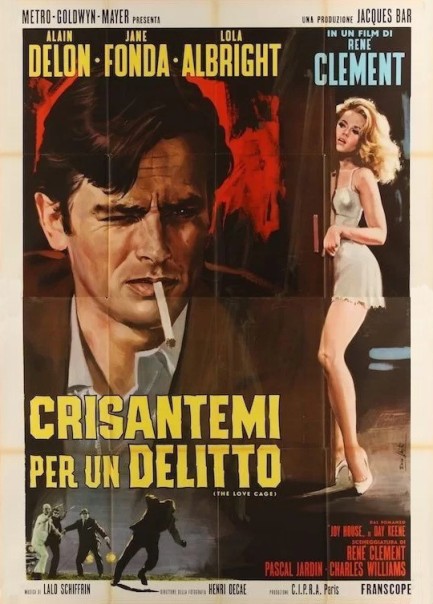 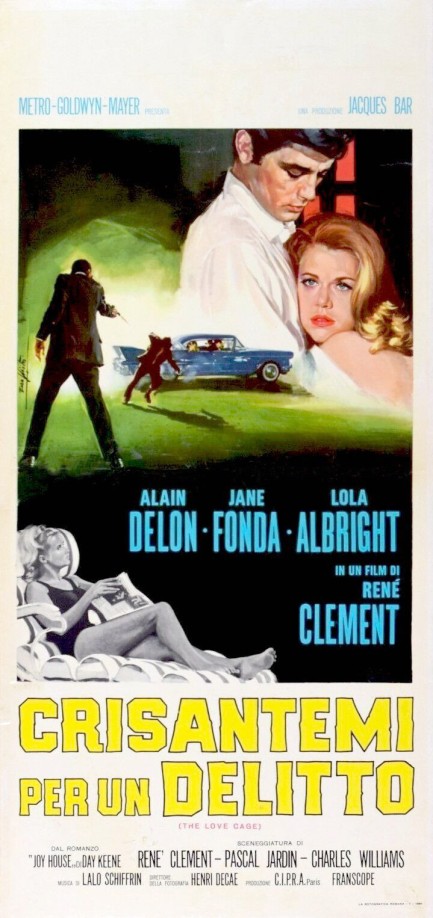
The posters you see here were made for the French thriller Les félins. While the French posters are fine, we thought these Italian promos were a bit more interesting. The first two were painted by Enzo Nistri, the second two by Sandro Symeoni. The movie was called Crisantemi per un delitto in Italy—“chrysanthemums for a crime.” No idea why. But fine, it's lyrical, which is never bad. It's based on the imaginative Day Keene novel Joy House, which is the title the movie retained for its U.S. run. In the book a derelict is plucked from a Chicago homeless shelter by a rich widow who needs a chauffeur, but her benevolence seems likely to backfire because her new driver was in the shelter only because it offered a perfect hiding place from mobsters seeking to kill him. But she has her own secret plans, and they're as sinister as they come. Working from a screenplay co-written by director René Clément and crime author Charles Williams, the movie slightly alters the approach of Keene's book. With Lola Albright playing the widow and Alain Delon as the hunted man, the story is transplanted from urban Chicago to the Côte d'Azur. Pre-Barbarella Jane Fonda features in a co-starring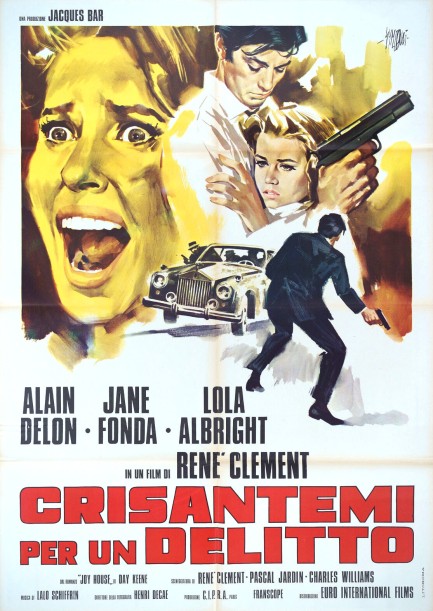 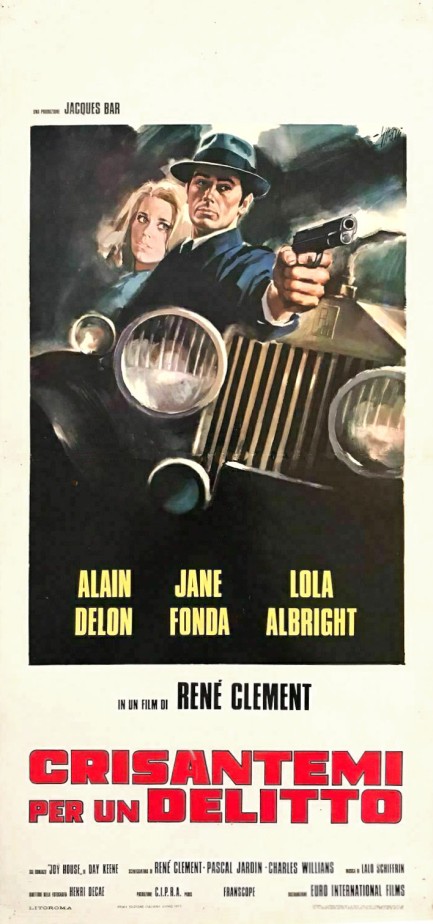 role as Albright's cousin and household helper. The two are soon in competition for Delon's affections, though he never forgets that his main goal is to escape the mobsters. While the general thrust of the plot remains a mystery as in Keene's novel, there's a heavy dose of action too, with excellent stunts. The ending differs as well. role as Albright's cousin and household helper. The two are soon in competition for Delon's affections, though he never forgets that his main goal is to escape the mobsters. While the general thrust of the plot remains a mystery as in Keene's novel, there's a heavy dose of action too, with excellent stunts. The ending differs as well.
The result is good, but also an example of both the highs and lows of French cinema of the period. Delon, Fonda, and Albright are decent actors bestowed a good script, and are all gorgeous and charismatic, but the movie spends a lot of time being cute. Even so, Clément and company pull it all together. Make sure you appreciate the production design, especially the Rolls Royce that Delon drives, with its completely transparent roof, c-pillars all. It's something we never knew existed. To us it looked like a good way to get heatstroke, but we guess it was made for rich occupants to see and be seen. We think Joy House should be seen. It premiered in France in June 1964, then opened at the Taormina Film Fest in Italy today the same year.
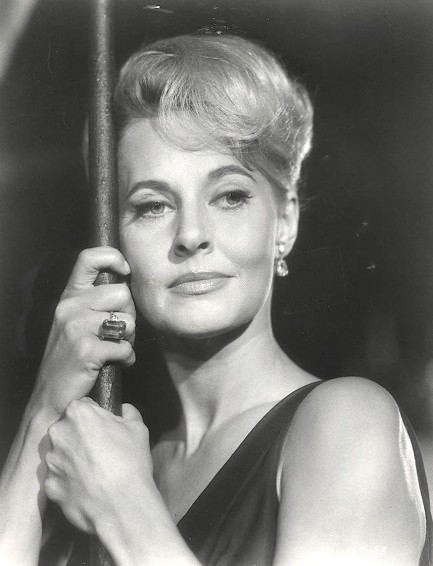  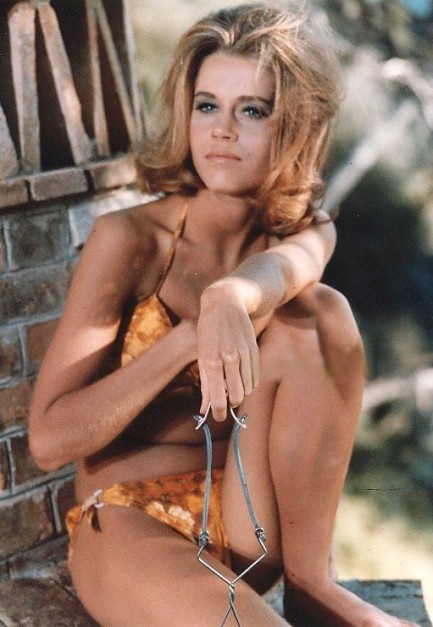 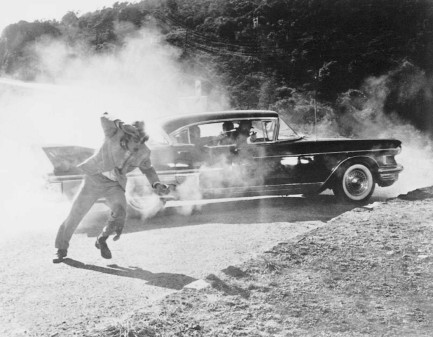   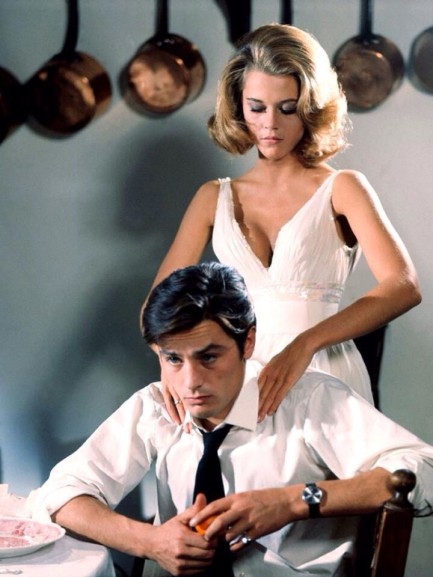 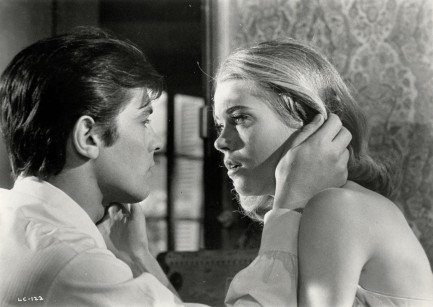 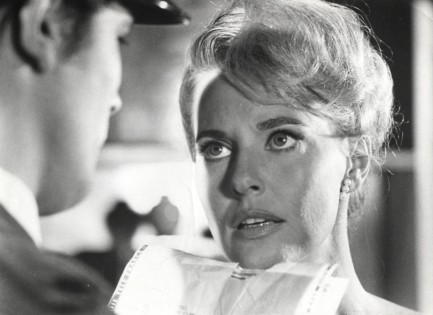  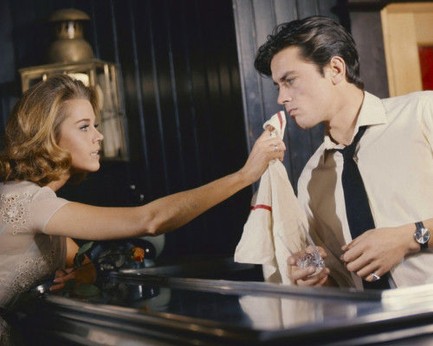 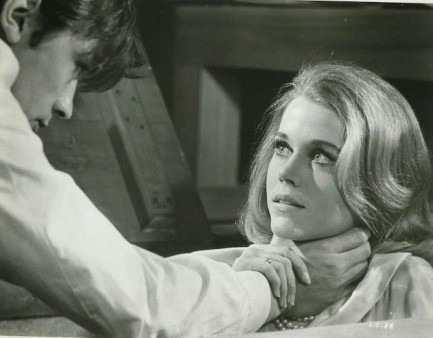 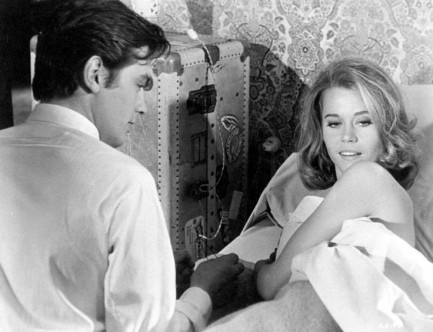 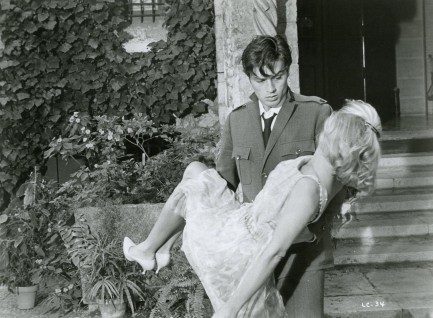 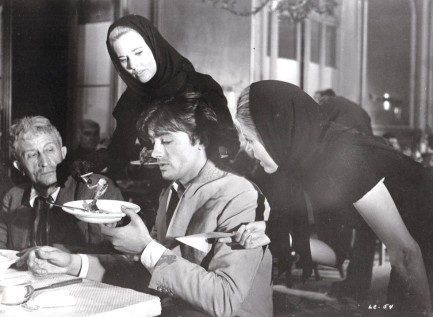 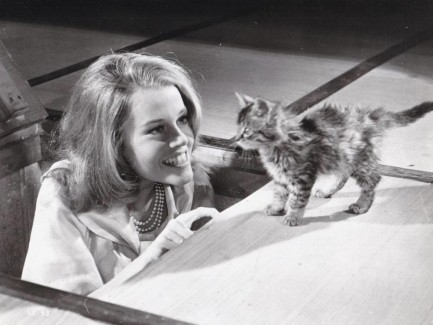 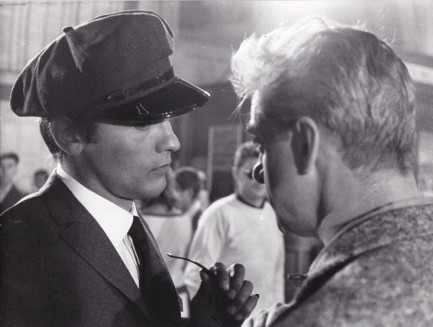 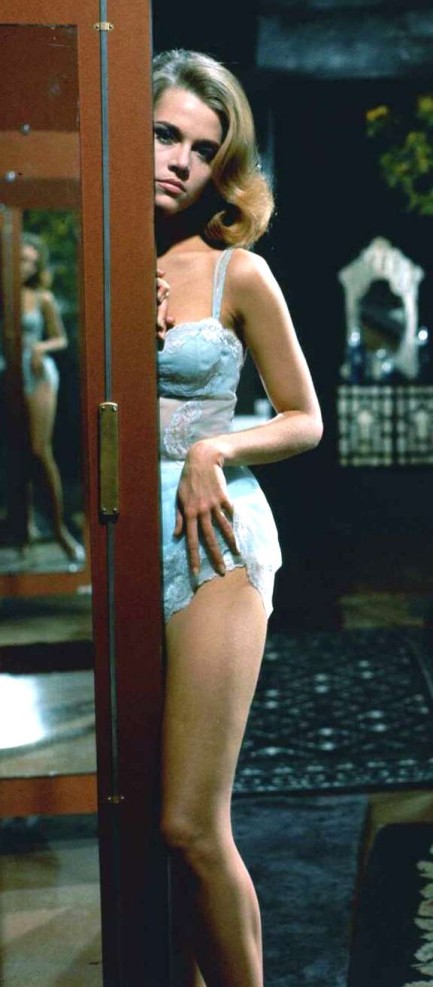 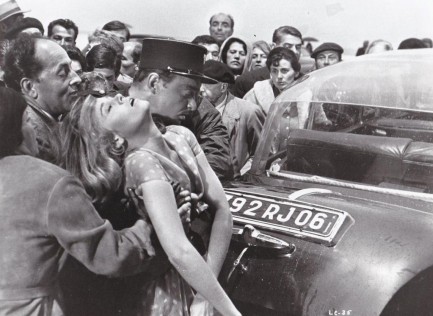 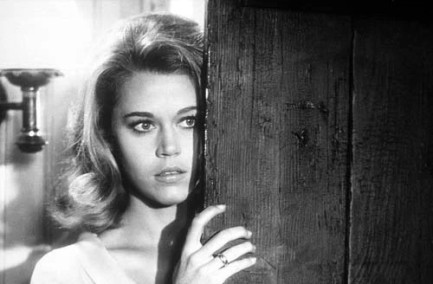 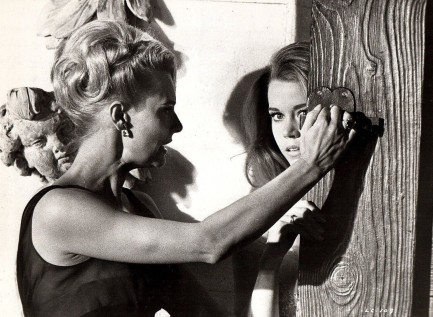 
 *sob* Have a few affairs, trash a hotel room, wreck a car, slap a child—and your reputation is ruined. It isn't fair. 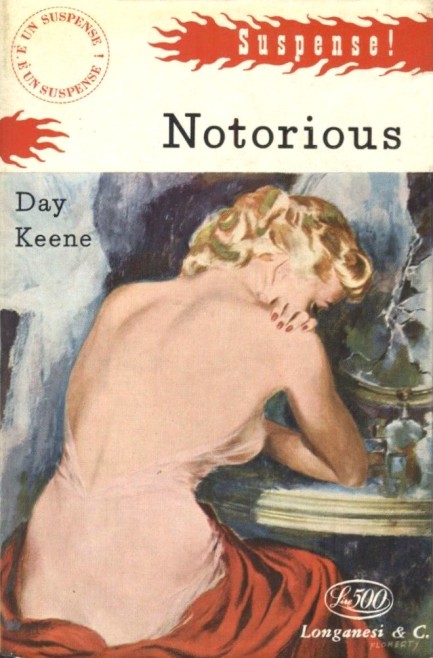
Above is a cover for Day Keene's 1954 novel Notorious, republished in Italian by Longanesi & Co. in 1958 with cover art by John Floherty, Jr. The art reminded us that we have a couple of Keene books, so we're going to move him near the top of the pile because he's always given us a wild read. Meanwhile, if all goes well, one of our beloved pulp mules will be bringing us a group of fun paperbacks from the U.S., including efforts from Milton K. Ozaki, Lou Cameron, Chester Himes, and Dorothy Salisbury Davis. We hope to have a summer of great reading.
 Excuse me, fellas, gotta go. Fleeting joy, followed by stinging disappointment and eventual doom are beckoning. 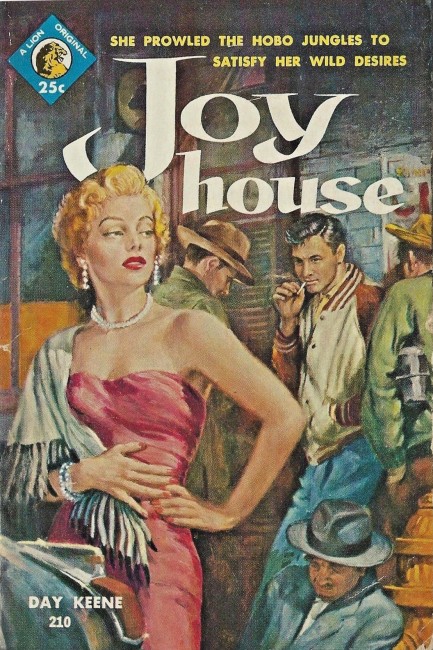
When you write more than fifty novels it helps to be highly imaginative, and Day Keene puts his brain through its paces in 1954's Joy House, a bizarre tale about a flashy mob lawyer named Mark Harris who flees his West Coast employers, wakes up in a Chicago mission after a five-week drinking binge, and is scooped up by a beautiful do-gooder widow who lives in a boarded up mansion. The widow became a recluse years earlier when her husband was murdered, and now all she does is take food to the mission three times a week, but when Harris moves into her house he awakens her dormant love glands and the two start really heating up the old pile of bricks.
As long as Harris keeps a low profile his pursuers won't have success, but he and the widow become increasingly public—something Harris can't avoid because he hasn't been truthful about hiding from mobsters who want to kill him. Luckily for him, she wants to start life anew, and suggests moving to Rio de Janeiro. Excellent idea, but there's more going on than Harris knows. As imaginative as this story is, it could have been better written—a hazard when you publish seven other novels in the same year—but overall we liked it. We like the uncredited cover too. We'll have more from Keene later. After all, with fifty-plus novels to his credit, he's almost unavoidable.
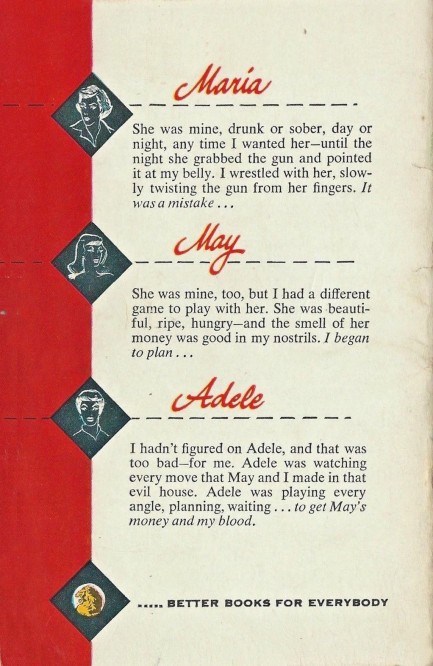
 I can feel you getting tense, baby. Just loosen up. This'll be great, I promise. 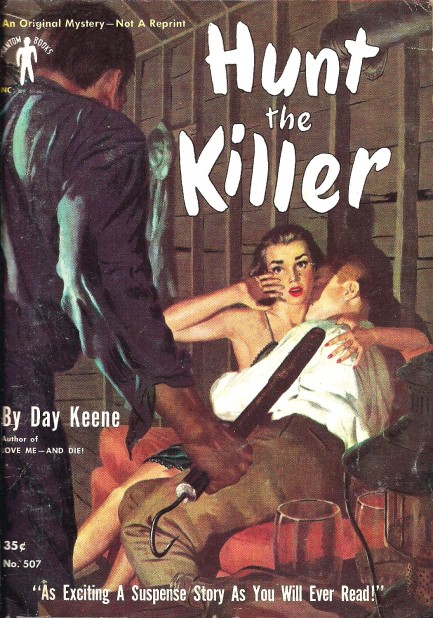 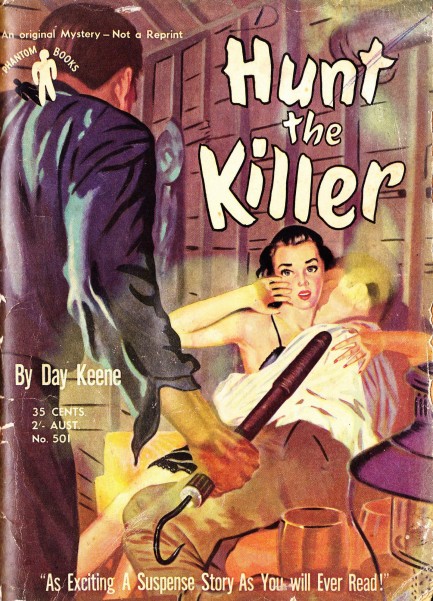 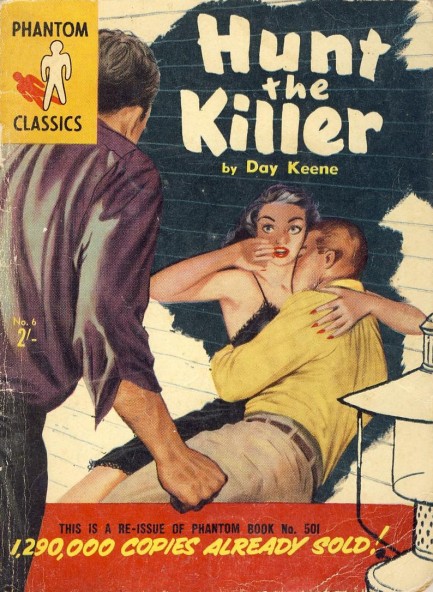
Sometimes the thing you're searching for finds you, especially in mid-century fiction. There were several covers produced for Day Keene's thriller Hunt the Killer, but the three used by Phantom Books were basically identical, and you see them above. The first came in 1951, the second in 1952, and the Phantom Classics edition in 1958. You see how the art was leached of its vividness with each subsequent release. It changes form too. The gaffing hook disappeared on the last cover. Did that happen because it was too violent, or too phallic, or both? We've yet to find a satisfactory explanation for why art changed this way for a company publishing the same book multiple times. Clearly they couldn't have lost rights to the original art, or else how could they have legally copied it? But if they had the rights, why use these progressively simpler versions? In this case we suspect Phantom wanted the cover to change with each edition to give it the sense of being a new product, but that's just a guess. The truth remains a mystery for now. In any case, interesting covers for Mr. Keene.
 Paperback publishers double down on a legendary model. 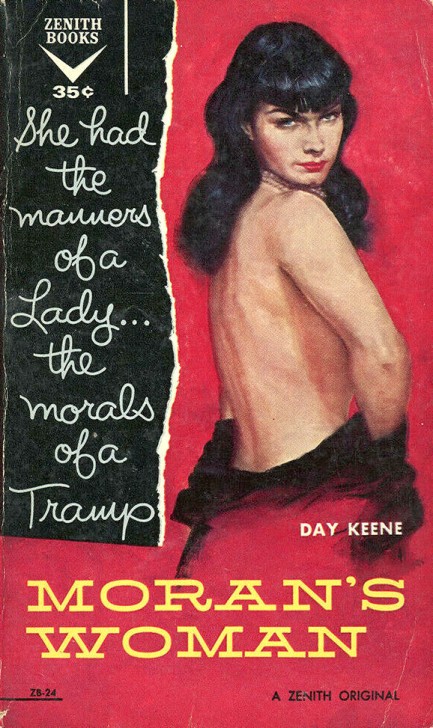 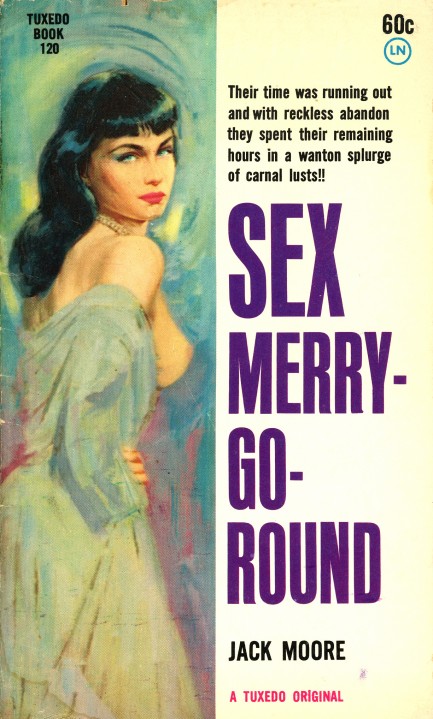
Bettie Page has long been an inspiration in multiple media, and you can include paperback art on the list. These two covers for authors Day Keene and Jack Moore, published in 1959 and 1962 respectively, use Page's instantly recognizable form to draw the eyes of newsstand browsers, a tactic we assume was a wild success. We love both of these, especially the top image by Jack Faragasso. There are even others from the period. The artist on the bottom cover is the legendary Unknown, by far the most prolific mid-century paperback illustrator of all time. We'll doubtless run across more from the same genius later.
 He's Keene on murder and mayhem. 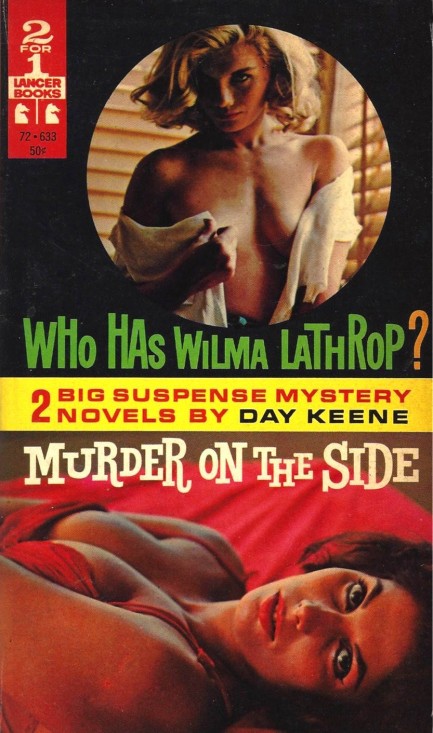 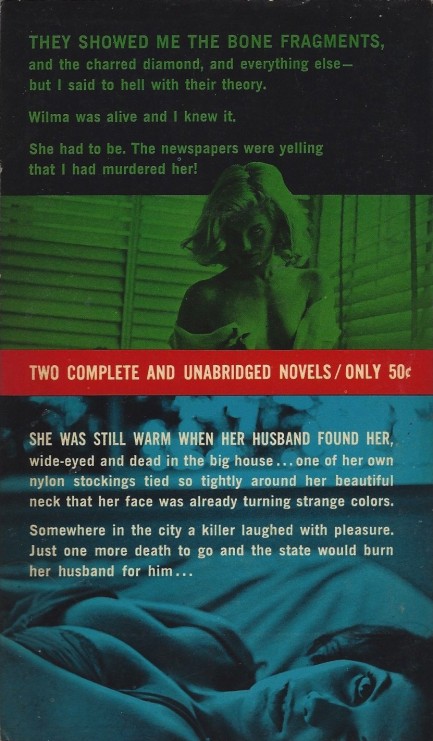
We don't generally like photo covers on paperbacks but this double from Lancer Books of the Day Keene novels Who Has Wilma Lathrop? and Murder on the Side is rather nice, with pretty colors and eye catching fonts. Murder on the Side deals with an ordinary guy who, when he tries to help his hot young secretary out of a sticky situation, gets involved in troubles more serious than he planned on. He goes from being bored with his life to risking it at every turn. As for the other book Wilma Lathrop, we already talked about it. You can read our bit on that here.
 As long as you're already feeling terrible I might as well tell you he landed on your cat. 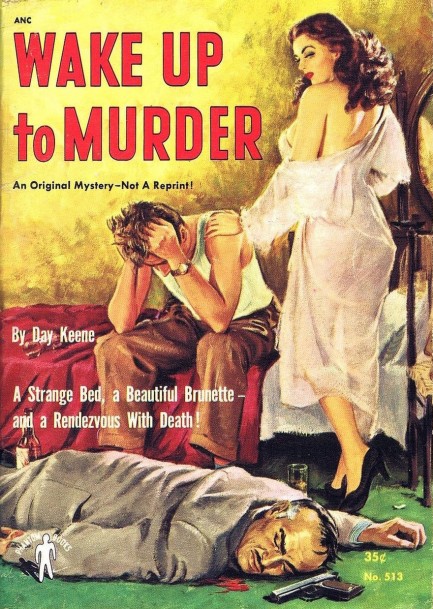
For such clever animals cats do get underfoot at inconvenient times, don't they? But fret not—no felines are flattened in Day Keene's Wake Up To Murder. There's barely any character development at all, let alone time for extraneous animals. What happens here is the protagonist James Charters decides to save a woman from death row. Sound familiar? That's because it's the same set-up Keene used for Death House Doll. Plotwise the books diverge from there, as Charters gets blamed for a couple of murders and has some mobsters chasing after him for $10,000 they think he has. Put this in the Florida thriller bin, copyright 1952.
 You can try to ransom me but my husband really doesn't answer the phone during football season. 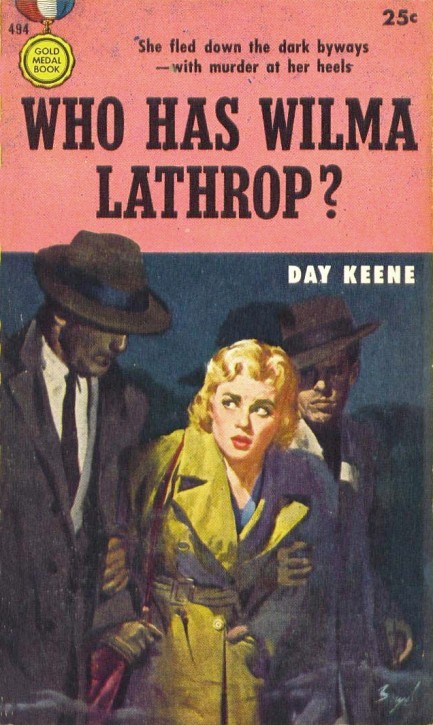
In Who Has Wilma Lathrop? a Chicago high school teacher marries the woman of his dreams after a three month courtship, but wakes up one morning to find her missing, and immediately thereafter discovers she has a hidden past as a gangster's mistress and possible jewel thief. Suddenly that whirlwind romance doesn't seem like it was a good idea, but he loves her and has to locate her. He's smart and has some combat training, so he isn't totally helpless, but finds himself in deeper and deeper trouble. This is a recommended yarn from Day Keene set in the middle of a bitter Chicago winter. If you're lucky enough to find the above 1955 Gold Medal edition you'll get great art by Barye Phillips.
 Tough time on the front, and unwelcome back at home. 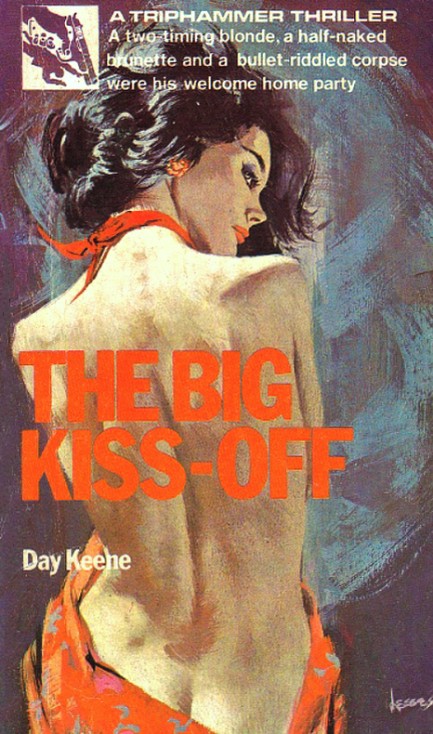
You'd never guess from the art, but The Big Kiss-Off deals with an Air Force pilot named Cade Cain who, after twelve years in Korea, returns to a life of boating around the Louisiana bayou and comes across the bodies of six Chinese men on an isolated mud flat. And on his first day back, too, which is pretty bad luck, even for a guy who got shot down and spent two years in a prison camp. He wants nothing to do with the bodies or whoever was responsible for putting them there, but somehow his old local nemesis learns of the find and before he knows it he's beaten, threatened, and told to leave town again—this time for good. Two fisted loners in mid-century fiction rarely take that sort of treatment laying down. When Cain learns that his wife has sold off his family's land, divorced him in absentia, and found comfort in his enemy's bed, something simply has to be done.
Before he gets his vengeful ducks in a row, a near-naked fugitive swims aboard his boat and the mystery deepens. Her name is Mimi Moran, because the alliteration is strong with this book. She's looking for her husband, who it happens is a pilot who flies illegal aliens into the U.S. for the bad guys. Cade Cain decides to help Mimi Moran and that's when the real trouble starts. The Big Kiss-Off is a solid yarn from Day Keene. It has the usual issues common to fiction of the 1950s, for example the hero having to constantly resist forcing himself on his beautiful passenger because he's “only human, after all.” Fortunately, even though “her flesh constantly attracted his hands like a magnet,” he contains himself—mostly. Not someone you'd want near your sister. Or any woman, really. But as a fictional hero he serves his purpose just fine.
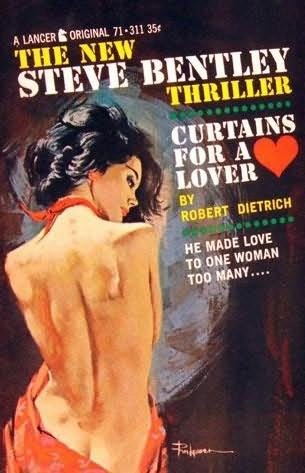 With a setting in the endlessly fertile (for genre fiction) Louisiana bayou, and a narrative that wastes no time putting Cain in hot water, The Big Kiss-Off keeps the pages turning. It originally appeared in 1954 but the above edition was published in 1972 by Triphammer Books in Britain, with nice art by Ron Lesser borrowed from Robert Dietrich's (E. Howard Hunt's) 1962 Lancer Books thriller Curtains for a Lover. Notice how Triphammer erased part of Lesser's distinctive signature. That was obviously to keep the figure on their cropped art from looking crowded by the lettering, but we imagine it still annoyed Lesser. You can see a U.S. cover for The Big Kiss-Off in this collection of Day Keene novels we put together back in 2009. With a setting in the endlessly fertile (for genre fiction) Louisiana bayou, and a narrative that wastes no time putting Cain in hot water, The Big Kiss-Off keeps the pages turning. It originally appeared in 1954 but the above edition was published in 1972 by Triphammer Books in Britain, with nice art by Ron Lesser borrowed from Robert Dietrich's (E. Howard Hunt's) 1962 Lancer Books thriller Curtains for a Lover. Notice how Triphammer erased part of Lesser's distinctive signature. That was obviously to keep the figure on their cropped art from looking crowded by the lettering, but we imagine it still annoyed Lesser. You can see a U.S. cover for The Big Kiss-Off in this collection of Day Keene novels we put together back in 2009.
 Yes, I'd like to report a murder. A man murdered every last bit of my patience. 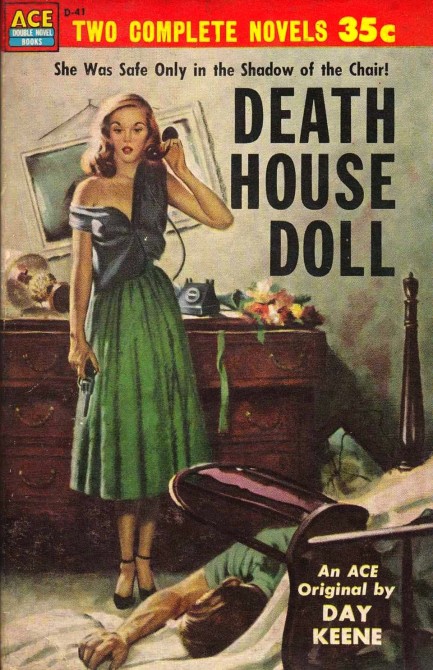
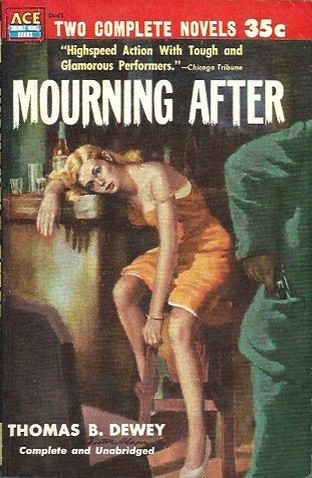 Above, a nice cover for Day Keene's 1954 thriller Death House Doll, with excellent art credited to Bernard Barton, who's aka Harry Barton (Bernard was his middle name). In the story, a Korean War vet has promised his fatally wounded brother he'd look after his wife and baby daughter, but when he gets back to the world (Chicago) he's stunned to find that she's sitting on death row for murder, and unwilling to spill the truth even if it saves her. The attraction with this one is watching a decorated war hero run riot on hoods and thieves, while up against the always effective ticking clock gimmick—an execution date, which in this case is five days hence. The book was an Ace Double with Thomas B. Dewey's Mourning After on the flipside, and the art on that one, just above, is by Victor Olson. We put together a nice collection of Harry Barton's work back in May that we recommend you visit at this link. Above, a nice cover for Day Keene's 1954 thriller Death House Doll, with excellent art credited to Bernard Barton, who's aka Harry Barton (Bernard was his middle name). In the story, a Korean War vet has promised his fatally wounded brother he'd look after his wife and baby daughter, but when he gets back to the world (Chicago) he's stunned to find that she's sitting on death row for murder, and unwilling to spill the truth even if it saves her. The attraction with this one is watching a decorated war hero run riot on hoods and thieves, while up against the always effective ticking clock gimmick—an execution date, which in this case is five days hence. The book was an Ace Double with Thomas B. Dewey's Mourning After on the flipside, and the art on that one, just above, is by Victor Olson. We put together a nice collection of Harry Barton's work back in May that we recommend you visit at this link.

|
 |

The headlines that mattered yesteryear.
2003—Hope Dies
Film legend Bob Hope dies of pneumonia two months after celebrating his 100th birthday. 1945—Churchill Given the Sack
In spite of admiring Winston Churchill as a great wartime leader, Britons elect
Clement Attlee the nation's new prime minister in a sweeping victory for the Labour Party over the Conservatives. 1952—Evita Peron Dies
Eva Duarte de Peron, aka Evita, wife of the president of the Argentine Republic, dies from cancer at age 33. Evita had brought the working classes into a position of political power never witnessed before, but was hated by the nation's powerful military class. She is lain to rest in Milan, Italy in a secret grave under a nun's name, but is eventually returned to Argentina for reburial beside her husband in 1974. 1943—Mussolini Calls It Quits
Italian dictator Benito Mussolini steps down as head of the armed forces and the government. It soon becomes clear that Il Duce did not relinquish power voluntarily, but was forced to resign after former Fascist colleagues turned against him. He is later installed by Germany as leader of the Italian Social Republic in the north of the country, but is killed by partisans in 1945.
|

|
|

It's easy. We have an uploader that makes it a snap. Use it to submit your art, text, header, and subhead. Your post can be funny, serious, or anything in between, as long as it's vintage pulp. You'll get a byline and experience the fleeting pride of free authorship. We'll edit your post for typos, but the rest is up to you. Click here to give us your best shot.

|
|




 role as Albright's cousin and household helper. The two are soon in competition for Delon's affections, though he never forgets that his main goal is to escape the mobsters. While the general thrust of the plot remains a mystery as in Keene's novel, there's a heavy dose of action too, with excellent stunts. The ending differs as well.
role as Albright's cousin and household helper. The two are soon in competition for Delon's affections, though he never forgets that his main goal is to escape the mobsters. While the general thrust of the plot remains a mystery as in Keene's novel, there's a heavy dose of action too, with excellent stunts. The ending differs as well.










































 With a setting in the endlessly fertile (for genre fiction) Louisiana bayou, and a narrative that wastes no time putting Cain in hot water, The Big Kiss-Off keeps the pages turning. It originally appeared in 1954 but the above edition was published in 1972 by Triphammer Books in Britain, with nice art by Ron Lesser borrowed from Robert Dietrich's (E. Howard Hunt's) 1962 Lancer Books thriller Curtains for a Lover. Notice how Triphammer erased part of Lesser's distinctive signature. That was obviously to keep the figure on their cropped art from looking crowded by the lettering, but we imagine it still annoyed Lesser. You can see a U.S. cover for The Big Kiss-Off in this collection of Day Keene novels we put together back in 2009.
With a setting in the endlessly fertile (for genre fiction) Louisiana bayou, and a narrative that wastes no time putting Cain in hot water, The Big Kiss-Off keeps the pages turning. It originally appeared in 1954 but the above edition was published in 1972 by Triphammer Books in Britain, with nice art by Ron Lesser borrowed from Robert Dietrich's (E. Howard Hunt's) 1962 Lancer Books thriller Curtains for a Lover. Notice how Triphammer erased part of Lesser's distinctive signature. That was obviously to keep the figure on their cropped art from looking crowded by the lettering, but we imagine it still annoyed Lesser. You can see a U.S. cover for The Big Kiss-Off in this collection of Day Keene novels we put together back in 2009.

 Above, a nice cover for Day Keene's 1954 thriller Death House Doll, with excellent art credited to Bernard Barton, who's aka Harry Barton (Bernard was his middle name). In the story, a Korean War vet has promised his fatally wounded brother he'd look after his wife and baby daughter, but when he gets back to the world (Chicago) he's stunned to find that she's sitting on death row for murder, and unwilling to spill the truth even if it saves her. The attraction with this one is watching a decorated war hero run riot on hoods and thieves, while up against the always effective ticking clock gimmick—an execution date, which in this case is five days hence. The book was an Ace Double with Thomas B. Dewey's Mourning After on the flipside, and the art on that one, just above, is by Victor Olson. We put together a nice collection of Harry Barton's work back in May that we recommend you visit at this link.
Above, a nice cover for Day Keene's 1954 thriller Death House Doll, with excellent art credited to Bernard Barton, who's aka Harry Barton (Bernard was his middle name). In the story, a Korean War vet has promised his fatally wounded brother he'd look after his wife and baby daughter, but when he gets back to the world (Chicago) he's stunned to find that she's sitting on death row for murder, and unwilling to spill the truth even if it saves her. The attraction with this one is watching a decorated war hero run riot on hoods and thieves, while up against the always effective ticking clock gimmick—an execution date, which in this case is five days hence. The book was an Ace Double with Thomas B. Dewey's Mourning After on the flipside, and the art on that one, just above, is by Victor Olson. We put together a nice collection of Harry Barton's work back in May that we recommend you visit at this link. 




































































